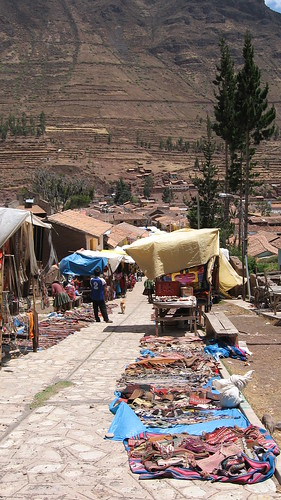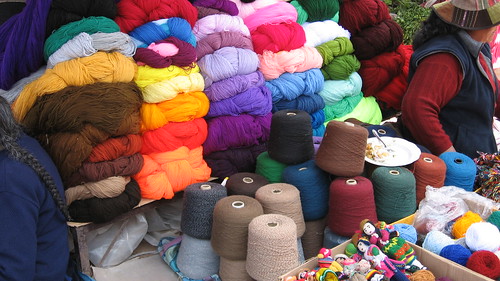crafty on the road - sacred valley crafts
 By far the craftiest component of my trip has been my time in the Sacred Valley. This is the area surrounding the capital of the Inca empire, Cusco - a lovely (if gringo infested) city that most people use as the jumping off point to Machu Picchu. The Valley area (also known as the Cusco region) is chockful of Inca ruins that hold spiritual significance for many Peruvians, and for new-agey types internationally. Instead of ruin hopping I pursued my spiritual practice of choice: visiting local markets and artisan shops.
By far the craftiest component of my trip has been my time in the Sacred Valley. This is the area surrounding the capital of the Inca empire, Cusco - a lovely (if gringo infested) city that most people use as the jumping off point to Machu Picchu. The Valley area (also known as the Cusco region) is chockful of Inca ruins that hold spiritual significance for many Peruvians, and for new-agey types internationally. Instead of ruin hopping I pursued my spiritual practice of choice: visiting local markets and artisan shops.It is hard to walk a block in any Peruvian city, town, or mountain range without hitting some sort of market. The major ones in the Cusco region are the Sunday market at Pisac and at Chinchero.
 Mari of Las Pallas had warned me that they have become increasingly junky, and I must admit to becoming a little jaded through overexposure to the mass amount of tourist-oriented crap being shilled at these markets and otherwise (such as cheapo synthetic fibres and slapdash workmanship, if items were even made by a human being). But with some patience and a certain amount of resistance to the constant call of ¨Seniorita! Chullos, mantas, ponchos, very beautiful!¨, some lovely stuff can indeed be found. The best part is that many booths are occupied by women and children weaving on backstrap looms or spinning sheep or alpalca wool on spindles.
Mari of Las Pallas had warned me that they have become increasingly junky, and I must admit to becoming a little jaded through overexposure to the mass amount of tourist-oriented crap being shilled at these markets and otherwise (such as cheapo synthetic fibres and slapdash workmanship, if items were even made by a human being). But with some patience and a certain amount of resistance to the constant call of ¨Seniorita! Chullos, mantas, ponchos, very beautiful!¨, some lovely stuff can indeed be found. The best part is that many booths are occupied by women and children weaving on backstrap looms or spinning sheep or alpalca wool on spindles.

The artesania that I was most impressed with (and sadly, least able to afford) was the stuff produced by initiatives that focus on preserving natural dyeing and weaving techniques. I was thrilled to discover casa ecologica in the lovely little town of Ollantaytambo. The Casa sells locally produced textiles, ceramics, yummy organic treats, and medicines. Almost all textiles are made with organic, natural dyes and fibres. Traditional knowledge is shared among Ollantaytambo region communities, where a textile practicioner versed in natural techniques visits communities that have become dependent on synthetic materials and shows them what´s up.




If this sounds familiar, perhaps you read my last post about the Centre for Traditional Textiles based in the city of Cusco. Since the late 1970s, Nilda Callañaupa has been working with communities in the Cusco area in persuing a mission to revive ancient Incan styles and techniques that were/are dying out due to the tourist demand for non-traditional weavings. Today the CTTC - a non-profit org since 1996 - works with Quecha weavers and their families to engage in skill-building, community networking, and market development. In addition to the sale of top-quality weavings produced by the CTTC communities, the centre in Cusco city (Avenida Sol 603) houses a must-see museum that investigates the art and culture of weaving in the Cusco region, as well as an ongoing weaving demo by weavers from multiple participating communities.


I took a mini weaving course through the CTTC´s education centre and produced part of a little Jakima (belt), which really hammered home how much skill and energy goes in to the production of the the insanely complex works done by master (and even intermediate) weavers at the Centre and elsewhere.


Incidentally, while I was learning to weave at her Centre, Nilda, the director of the CTTC was in Toronto for the Textile Society of America´s biennial symposium. The coincidence factor was magnified when I just happened to meet her brother, Angel, at his lovely little textile shop & natural dye education centre (Kamaq Maki - Calle Rumañawi #3) in Chinchero, and watched their mother in action at the Chinchero branch of the CTTC. Small world indeed....
Kamaq Maki



CTTC: Chinchero branch


stay tuned for the next dispatch






















0 Comments:
Post a Comment
<< Home